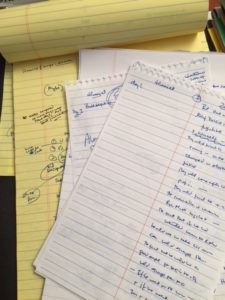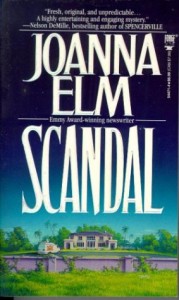 It’s Squib Saturday, and usually I share the most interesting, entertaining or outrageous tidbit of information I’ve gleaned from something I’ve read or done over the past week. Today, I have to cheat, and republish a funny squib I posted last year about fake news. Let me, please, explain:
It’s Squib Saturday, and usually I share the most interesting, entertaining or outrageous tidbit of information I’ve gleaned from something I’ve read or done over the past week. Today, I have to cheat, and republish a funny squib I posted last year about fake news. Let me, please, explain:
For the last few weeks, I have been preparing the opening chapters of Book 3 for a First-Ten-Pages Boot Camp. It’s an online workshop run by the agents of the Talcott Notch Literary Agency who evaluate the first 2,500 words of a novel.
Jumpstart
The idea behind the course is that literary agents and acquisitions editors in the major publishing houses receive so many queries and manuscripts they have time to read only the first couple of pages. If an author doesn’t grab their attention in those pages, it’s curtains!
My enrollment in the course was prompted by the sad feeling that I needed a jumpstart to return to my manuscript after attending a novel workshop in St. Augustine which I wrote about here and here. Specifically, I returned from the workshop with a slew of suggestions buzzing around in my head, and a realization that I needed to rewrite the opening of my thriller to focus on my antagonist.
Test-Drive

 The rewrite went slowly, and involved lots of procrastination (new thriller, Since We Fell, by Dennis Lehane, new season of Veep on HBO ; current season of White House Bloopers (a daily show on any cable TV news channel.) I enrolled in the Boot Camp to give myself a deadline. However, before submitting the first ten pages to the Boot Camp I decided to test-drive them with a beta reader I knew would give me the unvarnished truth — my brother, Michael. Indeed, that’s what I got: “Okay, it’s interesting, I’d like to know more, but I wouldn’t stay up at night to carry on reading. It’s not a page-turner like your first book (Scandal.)
The rewrite went slowly, and involved lots of procrastination (new thriller, Since We Fell, by Dennis Lehane, new season of Veep on HBO ; current season of White House Bloopers (a daily show on any cable TV news channel.) I enrolled in the Boot Camp to give myself a deadline. However, before submitting the first ten pages to the Boot Camp I decided to test-drive them with a beta reader I knew would give me the unvarnished truth — my brother, Michael. Indeed, that’s what I got: “Okay, it’s interesting, I’d like to know more, but I wouldn’t stay up at night to carry on reading. It’s not a page-turner like your first book (Scandal.)
Kiss of Death
Back to the drawing board. I had to write and edit furiously to make the deadline. That doesn’t mean I didn’t have time to find a new squib for this week, but then I revisited some scenes in Book 3 set in the newsroom of a tawdry supermarket tabloid. And that reminded me of a blog I posted about the heyday of fake news when readers could tell the difference between real and fake news, and were not confused by Donald Trump labelling all mainstream media as the “dishonest media.” It made me laugh. So here is a partial reprint for those readers who missed it last year:
Oh my! Oh my!
 Fake news is not a by-product of the digital age. It existed decades ago in varying degrees. Before Infowars, before Breitbart (“Birth Control Makes Women Unattractive and Crazy”) we had the supermarket tabloids. In the interests of full disclosure, I was the news editor of one of them, Star Magazine, but while I was news editor, at least, I know that the Star never knowingly published a fake news story. However, the bottom feeders in this group, publications like the now-defunct Weekly World News and Sun, with their tawdry front pages nestling at the bottom of racks in supermarket checkouts were a different matter.
Fake news is not a by-product of the digital age. It existed decades ago in varying degrees. Before Infowars, before Breitbart (“Birth Control Makes Women Unattractive and Crazy”) we had the supermarket tabloids. In the interests of full disclosure, I was the news editor of one of them, Star Magazine, but while I was news editor, at least, I know that the Star never knowingly published a fake news story. However, the bottom feeders in this group, publications like the now-defunct Weekly World News and Sun, with their tawdry front pages nestling at the bottom of racks in supermarket checkouts were a different matter.
Lessons from the Past
Where am I going with this? To share my memory of one of the funniest fake news stories of that era, and its consequences.
The fake news story in question was published by the now-defunct Sun in 1992. The headline on the story was : “World’s Oldest Newspaper Carrier, 101, Quits Because She’s Pregnant.” The story stated she was quitting because she had become pregnant by a millionaire in Stirling, Australia. None of it was true: No millionaire. No pregnant 101-year old, and no such place as Stirling, Australia. But, so far so good, right? Entertaining story; no harm done.
However, the publication needed a photo of this phenomenally fecund newspaper carrier because as everyone knows, a photo is worth a 1,000 words. According to well-circulated bar stories at the time, the photo editor tasked with the assignment went into the publication archives and found a photo of a newsstand operator in Arkansas. The photo was dated 1980, and the newspaper carrier in the photo was identified as being about 80 years old at the time. Good enough, he thought. What are the chances that this lady is still alive? And, so the Sun ran the photo, with her posing in front of her newsstand, alongside the story.
Fiction & Fantasy
 The rest of the story belongs to the publication’s litigation history since the newspaper carrier in Arkansas was still alive, was 96, and was alerted to the article — and her photo– by a neighbor. She was eventually awarded $1.5 million in damages by a federal court. But, that isn’t even the best part of the story.
The rest of the story belongs to the publication’s litigation history since the newspaper carrier in Arkansas was still alive, was 96, and was alerted to the article — and her photo– by a neighbor. She was eventually awarded $1.5 million in damages by a federal court. But, that isn’t even the best part of the story.
No, the funniest part of the story is the defense that was offered up by Sun editors and lawyers at the trial: something to the effect that the story couldn’t be defamatory because “everyone knows the Sun isn’t a real newspaper, and that the stories in it are all fiction and fantasy.”
It didn’t do the Sun any good in court, but yes, back then, most readers who picked up their “newspapers” at the supermarket checkout pretty much knew they were picking up entertainment, pulp fiction about alien babies, UFOs and Bat Cave dwellers, and not news stories meant to be taken seriously.
Today’s Problem
Today, it’s much more difficult. By the time snippets from legitimate news sites and from online sites masquerading as news sites are tweeted and re-tweeted, and posted to Facebook timelines, who can tell what’s real and what’s fake?
Who can tell what’s real and what’s fake?
AKA
who can tell whats non fiction or fiction?